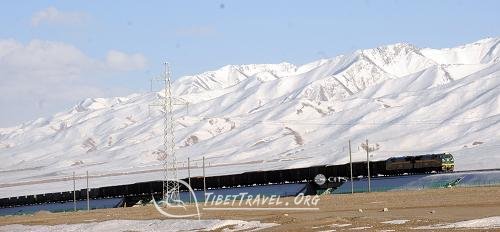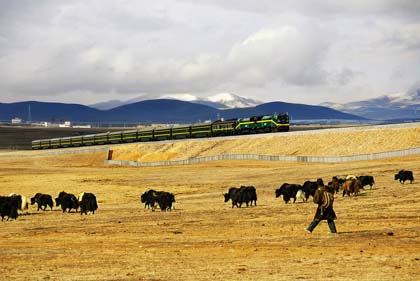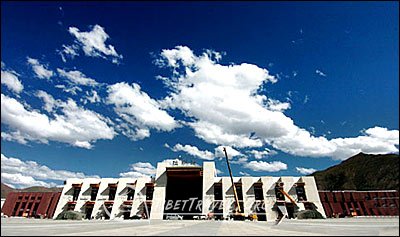Qinghai Tibet Railway: All about the World’s Highest Train
Extending 1,956 kilometers on the Qinghai-Tibet Plateau, the Qinghai-Tibet Railway connects Xining, the capital of Qinghai Province, and Lhasa, the capital of Tibet Autonomous Region. The Qinghai-Tibet Railway ended Tibet’s history without a railway and set a new record for the world’s highest railway.
Since its operation, the Qinghai-Tibet Railway has become one of the busiest railways in Asia. Millions of travelers flock to the Qinghai-Tibet Plateau to experience this great work on the snowfields.
In order to help you know more about this remarkable achievement, often referred to as the ‘Heavenly Road’, we have compiled an extensive resource offering invaluable information on the world’s highest railway. This includes how the engineers overcame the challenges of its construction, where travelers can take a train to Lhasa, how to book train tickets to Tibet, what you can experience along the railroad, and so on.
Now, let's embark on your captivating journey along the Tibet Railway.
 1. When was the Qinghai Tibet Railway Built?
1. When was the Qinghai Tibet Railway Built?
 2. Why is the Qinghai-Tibet Railway an Engineering Miracle?
2. Why is the Qinghai-Tibet Railway an Engineering Miracle?
 3. What is the significance of the Qinghai Tibet railway?
3. What is the significance of the Qinghai Tibet railway?
 4. The Map of Qinghai Tibet Railway and the Main Destinations along the Way
4. The Map of Qinghai Tibet Railway and the Main Destinations along the Way
 5. How long does it take to travel to Tibet by the Qinghai-Tibet Railway?
5. How long does it take to travel to Tibet by the Qinghai-Tibet Railway?
 6. The Scenery and What to Enjoy along the Qinghai-Tibet Railway
6. The Scenery and What to Enjoy along the Qinghai-Tibet Railway
 7. How is the onboard experience of the Qinghai-Tibet railway?
7. How is the onboard experience of the Qinghai-Tibet railway?
 8. How to book a Ticket for Qinghai-Tibet railway?
8. How to book a Ticket for Qinghai-Tibet railway?
 9. How to take the Qinghai-Tibet railway from Beijing, Shanghai, Chengdu, Chongqing, Guangzhou, etc?
9. How to take the Qinghai-Tibet railway from Beijing, Shanghai, Chengdu, Chongqing, Guangzhou, etc?
 10. The Tibet Railway to Nepal via Shigatse and Nyingchi, and when it will be complete?
10. The Tibet Railway to Nepal via Shigatse and Nyingchi, and when it will be complete?
1. When was the Qinghai Tibet Railway Built?
The construction of the Qinghai-Tibet Railway commenced in 1958 and reached completion in 2006. In 1955, the great Chinese leader Mao Zedong sent a team to the Tibetan plateau to explore the feasibility of this ambitious railway project.
Since then, China has facing numerous difficulties and consuming half a century, and finally to build the fantastic railway to Lhasa.
In 2006, the Qinghai Tibet Railway was finally finished, and in 2014, the extension of the Qinghai Tibet Railway from Lhasa to Shigatse was completed and put into operation.
2. Why is the Qinghai-Tibet Railway an Engineering Miracle?
"It is impossible to build a railway to Lhasa across the Kunlun Mountain Range," declared the modern railway travel expert, Mr.Paul, in his book "Travel Around China". In such complex geological conditions, it was extremely difficult to build roads and rail tracks on the snowland.
With 960 kilometers of the railway soaring to an elevation of 4,000 meters above sea level, the designers and engineers of the Qinghai-Tibet railway were confronted with a host of obstacles. The three major challenges faced were the fragile ecosystem, the lack of oxygen, and permafrost.
At the same time, such a feat of engineering must require huge investment, which was a big challenge for China at the time.
However, the biggest challenges were presented by the harsh geographic conditions on the high plateau. The fragile ecosystem on the Qinghai-Tibet Plateau, and also the lack of oxygen at the high altitudes, and the permafrost were major problems that made the construction of the Qinghai-Tibet Railway specifically eventful. Under such great difficulties, that’s why we say the Qinghai Tibet Railway is the miracle of human construction in history.
3. What is the significance of the Qinghai Tibet railway?
It represents a pioneering feat in engineering and infrastructure, conquering the formidable challenges posed by high altitudes and harsh terrains.
Moreover, the Qinghai-Tibet railway has brought substantial economic development to the Tibetan Plateau. It has stimulated trade, bolstered local industries, and created employment opportunities.
One of its most notable impacts is tourism. The Qinghai-Tibet railway has opened up Tibet to tourism on a larger scale. The Tibet train has become a popular way to Tibet, offering an in-depth travel experience of enjoying breathtaking views of the Tibetan plateau and its unique landscapes.
4. The Map of Qinghai Tibet Railway and the Main Destinations along the Way
As one of the world’s most remarkable railway routes, the Qinghai-Tibet railway spans approximately 1,956 kilometers, extending from Xining, Qinghai’s provincial capital, to Lhasa, the capital of the Tibet Autonomous Region.
This intricate map showcases the railway’s winding path through diverse landscapes, encompassing vast Hoh Xil No Man’s Land, towering snow-capped Tanggula Mountains, and the stunning northern Tibetan grasslands.
There are six major stations along the Qinghai-Tibet railway and 9 stations with sightseeing platforms marked on the map. You can get a detailed view of the Tibet railway route by the following map.
 The Map of Qinghai Tibet Railway & the Main Destinations along the Way.
The Map of Qinghai Tibet Railway & the Main Destinations along the Way.
5. How long does it take to travel to Tibet by the Qinghai-Tibet Railway?
The duration of a Tibet train journey on the Qinghai-Tibet Railway can vary based on the specific route and stops, but on average, it takes approximately 20 to 21 hours to travel from Xining to Lhasa.
The exact travel time may be subject to change due to schedules, it’s suggested to contact us in advance for the latest train schedule.
6. The Scenery and What to Enjoy along the Qinghai-Tibet Railway
Reputed as “the sky road”, the railway itself is a great wonder without a doubt. Of course, the breathtaking scenery along the Qinghai Tibet Railway gives additional attraction to this charming rail track. The journey of the Qinghai Tibet Railway is an extraordinary, exciting experience, especially the train climb up to Qinghai Tibet Plateau from Xining.
Embark on a journey through the Qinghai-Tibet railway, where the natural wonders of the Tibet Plateau unfold before your eyes. Marvel at the immense beauty of Qinghai Lake, the world’s largest saltwater lake, and traverse the ethereal high-altitude deserts near Golmud. As the train to Tibet weaves its path, you’ll witness the majesty of the snow-capped Kunlun Mountains and the remoteness of Hoh Xil National Nature Reserve, home to rare wildlife. Follow the meandering course of the Tuotuo River and ascend to the breathtaking Tanggula Pass, one of the world’s highest railway passes. Discover the pristine tranquility of Tsonag Lake and lose yourself in the boundless, rolling grasslands of the Tibetan Plateau. Each moment along this magical railway unveils a new facet of nature’s magnificence.
Do not miss any moment of extraordinary nature which you will watch through the window of the train. This magic railway goes through the distant lofty mountains, green rivers, blue lakes green oasis, and prairie. Changeable sky makes rain, snow, sun, and incredible weather.
 The stunning scenery along the Qinghai-Tibet Railway
The stunning scenery along the Qinghai-Tibet Railway
7. How is the onboard experience of the Qinghai-Tibet railway?
In order to ensure that the trains travel on the high plateau safely and passengers travel on board comfortably, all the trains to Tibet are well-designed taking the harsh conditions into account- high elevation, low temperature, lack of oxygen, harsh climate, etc.
The biggest feature of Tibet Train is the Oxygen supply system, travelling at an altitude above 4,000 meters, the Oxygen supply system onboard Tibet trains is the key element to ensuring passengers' comfort and safety.
There are two oxygen supply systems on each train. One is used for increasing the oxygen level in the train, by temperature and air pressure controlling systems, when the train enters the plateau zone. The other is directly used by passengers through an independent port. There are oxygen supply tubes and private oxygen masks in each cabin for emergencies.
As for accommodations, you have the choice of comfortable soft sleeper cabins or more budget-friendly hard sleeper berths. Additionally, each Tibet-bound train features a dining car offering three daily meals, predominantly Chinese and Tibetan cuisine. Passengers have access to both Asian and Western-style toilets on board.
While the journey can be long and conditions basic, it’s a unique opportunity to meet fellow travelers, experience Tibetan culture, and savor the stunning beauty of the Tibetan Plateau.
 Soft sleeper on the Tibet train
Soft sleeper on the Tibet train
8. How to book a Ticket for Qinghai-Tibet railway?
As the travel flow grows incredibly annually, travelling through the Qinghai Tibet Railway becomes increasingly popular, especially in peak seasons of Tibet tourism. Even if you make your reservation months in advance, it is virtually impossible for individual tourists to book a Tibet train ticket on their own.
As a licensed local travel agency, We, Tibet Vista, offer timely Tibet train ticket booking services and hassle-free ‘Train Ticket + Tibet Tour’ packages. If you book a Tibet tour with us, we could guarantee Xining to Lhasa train tickets if you prefer to get to Tibet by train. Contact us for all your Tibet train travel and ticket booking needs.
Please Notice:
Make your reservation as early as possible, particularly if you plan to visit Tibet during the peak summer tourist season. It takes time to apply for your Tibet Travel Permit and reserve your train ticket.
9. How to take the Qinghai-Tibet railway from Beijing, Shanghai, Chengdu, Chongqing, Guangzhou, etc?
Currently, seven cities from all directions in the mainland of China offer direct trains to Lhasa. These cities are Beijing in the north, Shanghai in the east, Guangzhou in the south, Chengdu and Chongqing in the central region, and Xining and Lanzhou in the west.
Since all trains to Tibet pass through Xining, you can have more chances to get a train ticket in Xining. For trains from other cities to Lhasa, there is only one scheduled train daily, even every other day in Chengdu and Chongqing.
You need to check the Tibet train schedule and fares in advance and make your reservation well in advance. The most convenient method is to have your travel agency book the ticket for you.
During the low season, like winter, it might be possible to book the Tibet train ticket online by yourself. However, in most cases, securing a Tibet train ticket can be challenging due to its popularity among both domestic and international travelers.
Ensure you obtain your Tibet Travel Permit beforehand, as you will need it to collect your ticket and board the Tibet train.
10. The Tibet Railway to Nepal via Shigatse and Nyingchi, and when it will be complete?
At present, there is still no direct railway from Lhasa to Kathmandu. According to the plan, the China-Nepal Railway is expected to be completed after 2030. The first section of this railway from Lhasa to Shigatse was successfully completed in 2014. However, the remaining section from Shigatse to Kathmandu is still in the planning stage.
Another extension of the Qinghai-Tibet railway from Lhasa to Nyingchi was officially opened in 2021. The Lhasa to Nyingchi train is the first high-speed train in Tibet. As per the plan, the railway from Lhasa to Nyingchi is intended to extend further eastward to Chengdu, Sichuan, becoming the second railway to access Tibet after the Qinghai-Tibet Railway, known as the Sichuan-Tibet Railway.
Conclusion
The Qinghai-Tibet Railway stands as a remarkable testament to human ingenuity and determination, connecting diverse landscapes and cultures. Beyond being an engineering marvel, it serves as a gateway to the mystical beauty of the Tibetan plateau, forging new connections, and enabling travelers to explore one of the world's most breathtaking regions.
If you are interested in any of the tourist destinations or have any questions about the Qinghai-Tibet train journey or travelling in Tibet, please feel free to send us an inquiry. We will do our best to help you out.

With exceptional passion and outstanding leadership, Mrs. Catherine has dedicated herself to Tibet inbound tourism and China tour for 15 years. As one of the handful females who see great potential of Chinese inbound tourism, Catherine has made great contribution to promoting Tibet tourism and enhancing the employment of Tibetans and prosperity of local Tibetan community.
Over the years, she travelled overseas with Tibet Tourism Bureau many times to promote Tibet tourism. Currently, Catherine works as the marketing director of Tibet Vista, an opinion leader behind the whole team of Tibet Vista.
Related Articles & Posts
Most Popular Tibet Tour Packages
-

Lhasa - Gyantse - Shigatse - Everest Base Camp - Shigatse - Lhasa
USD939
View Details -

Lhasa - Gyantse - Shigatse - E.B.C - Saga - Kailash Trek - Darchen - Lake Manasarovar - Saga - Gyirong - Tingri - Lhasa
USD2059
View Details -

10 Days Lhasa to Everest Base Camp and Namtso Lake Small Group Tour
Lhasa - Gyantse - Shigatse - EBC - Shigatse - Lhasa - Namtso Lake - Damxung - Lhasa
USD1289
View Details -

8 Days Driving Across Himalaya Overland Adventure from Kathmandu to Lhasa
Kathmandu - Gyirong - Everest Base Camp - Tingri - Shigatse - Gyantse - Lhasa
USD1069
View Details -

4 Days Lhasa Impression Small Group Tour: Explore the Heart of Tibet and Mingle with the Locals
Lhasa
USD509
View Details -

Lhasa - Gyantse - Shigatse - Everest Base Camp - Gyirong - Kathmandu
USD979
View Details -

Lhasa - Gyantse - Shigatse- Lhasa
USD799
View Details -

13 Day Lhasa, Mt. Everest, Mt. Kailash, Lake Manasarovar and Kathmandu Adventure Tour
Lhasa - Gyantse - Shigatse - EBC - Saga - Darchen - Kailash Trek - Darchen - Saga - Gyirong - Kathmandu
USD2059
View Details


.jpg)












